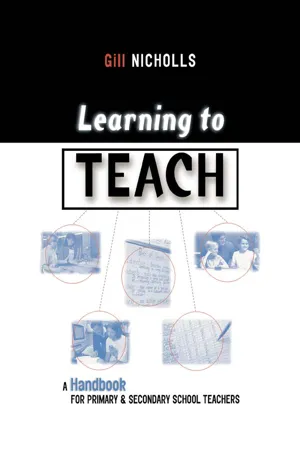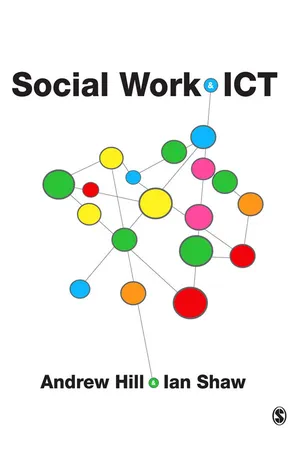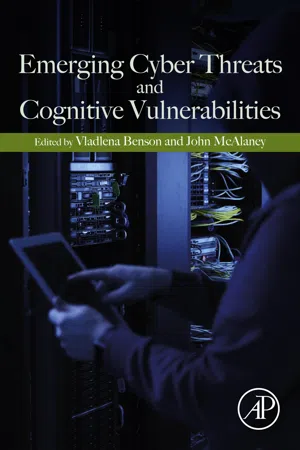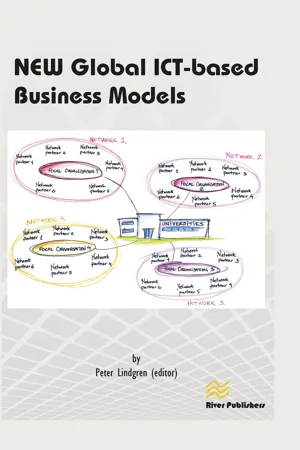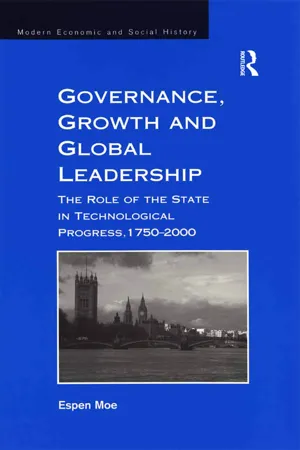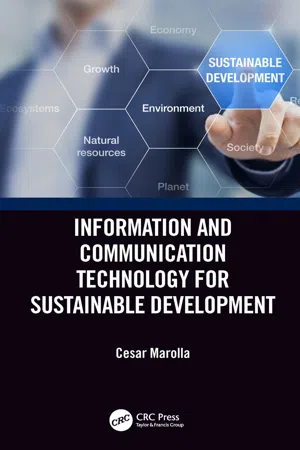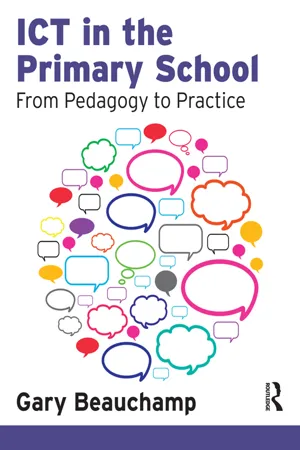Business
Information and Communication Technology in Business
Information and Communication Technology (ICT) in business refers to the use of digital technology to manage and process information, as well as facilitate communication within an organization. This includes hardware, software, networks, and other tools that enable businesses to streamline operations, improve efficiency, and enhance communication both internally and externally. ICT plays a crucial role in modern business operations and decision-making processes.
Written by Perlego with AI-assistance
Related key terms
10 Key excerpts on "Information and Communication Technology in Business"
- eBook - ePub
Learning to Teach
A Handbook for Primary and Secondary School Teachers
- Gill Nicholls(Author)
- 2014(Publication Date)
- Routledge(Publisher)
What is the difference between information technology (IT) and information and communication technologies (ICT)? There is considerable confusion among many educators about IT and ICT, especially in schools where, for example, many have now replaced the IT co-ordinator by the ICT co-ordinator. It is therefore important to be clear about the distinction especially as both are so important in teaching and learning.Information technology is the design, study and use of processes for representing physical, hypothetical or human relationships employing the collection, creation, storing, retrieving, manipulation, presentation, sending and receiving of information. IT is one of the National Curriculum subjects to be taught at all school levels, but the current National Curriculum orders (DfE, 1995) do not provide any guidelines as to whether or not it should be taught as a separate subject.Information and communication technologies are electronic and/or computerized devices and associated human interactive materials that enable the user to employ them for a wide range of teaching and learning processes in addition to personal use. ICT is being included in many new government initiatives that will be discussed later on.ICT includes computers, videos, televisions, connections with other computers, sensors, switches, interface boxes, the Internet which links computers globally together, telecommunications, satellite connections, and all the software and materials which enable us as teachers to use them to teach our pupils. Just as a television would be useless without visual and audio material reaching it through an aerial, video or cable, which we can then watch and hear, so a computer needs software to make it communicate with us, the user. These devices have an important place in education in all school subjects.The development of IT and ICT in education
It is only in recent years that the phrases ‘information technology’ and ‘information and communication technologies’ have come to be used in society and in education. Before that the most common phrases for IT and ICT in education were ‘computers in education’ and perhaps ‘microelectronics in education’. The use of computers in schools goes back many years, long before the requirements of the National Curriculum and there have been a series of government programmes since as early as 1974, with an investment of over £250m to support the use of computers and more recently ICT in education. More recent programmes and centres include: - eBook - ePub
- Andrew Hill, Ian Shaw(Authors)
- 2011(Publication Date)
- SAGE Publications Ltd(Publisher)
The purpose of the chapter is to prepare the ground for the remainder of the book by presenting a survey of social work contexts in which ICTs are being used. The remainder of the book is concerned with the impact that the use of these ICTs is having on social work as a whole. One of the key tasks will be to assess the extent to which the growing use of ICTs has met the policy objectives that lay behind their introduction. Are they achieving what was intended? Are there unforeseen consequences? This will require some critical thinking about the policy objectives themselves, and about how the impact of ICTs can be assessed. But in this chapter, questions about why ICTs have been introduced into social work are answered only from the perspective of their proponents. In other words, this chapter will report the claims made for the introduction and use of ICTs and later chapters will explore evidence relating to their impact in practice.First there is a short, introductory account of the available technologies. Second, there is a survey of social work practice that catalogues the various uses of ICT. Finally, there is a brief account of how service users are using ICT for peer support and for campaigning.What is ICT?
Information and Communication Technology is a broad term that is used to cover all the digital methods by which information is created, stored, manipulated and shared. This includes computer hardware and peripherals of all kinds, and the software and networks that they use to store, process and communicate information. It also includes digital broadcasting and mobile telecommunications technology.This definition covers all the standard software applications that are in use on individual personal computers in homes and offices; word processing, spreadsheets, presentations, desktop publishing, email and so on. But it is the increasing ease with which electronic data can be transferred to or from individual computers through local networks within organisations, or via the internet, that is producing the most rapid change in social work and elsewhere. For example, Web 2.0 technologies allow service users not only to view ‘static’ information about services over the internet but also to communicate with others, sometimes in real time, about their experiences of social work services. And sophisticated databases allow providers of social work services to collect information about service users and about how resources are being used, and to share that information with others. It is this second level of technology, moving beyond the individual personal computer, that is of primary interest here. What follows is a brief review of some of the key features of the ICTs that are discussed in this chapter. This is not, of course, an exhaustive list. A basic familiarity with word processing, spreadsheets, presentations, web browsers and email is assumed. - Vladlena Benson, John McAlaney(Authors)
- 2019(Publication Date)
- Academic Press(Publisher)
The continuous advancement of information technology (IT) impacts all sectors of the economy, both positively and negatively. The implementation of the Internet into business operations creates a paradigm shift from the traditional ways in which firms operated and interacted with customers and employees. However, it also increases the vulnerability to information security breaches (Arcuri, Brogi, & Gandolfi, 2017). The Internet, coupled with advancement in IT, makes virtual management of business possible and this allows for quicker and more efficient transactions. It also allows for online databases, which significantly reduce the time it takes to retrieve information while creating the possibility for linkages across them. With the escalating globalization forces and the added pressure of competition around the world, companies are increasingly applying the Internet as a strategic tool (Ching & Ellis, 2004 ; Pezderka & Sinkovics, 2011). The proliferative usage of information and communication technology (ICT) applications acts as a source for competitiveness and allows firms to grow (Higón, 2011 ; Jorgenson & Stiroh, 2000), enables them to control their processes (Jean, Sinkovics, & Cavusgil, 2010) and also allows them to expand their international activities (Sinkovics & Penz, 2005)- eBook - ePub
- Peter Lindgren(Author)
- 2022(Publication Date)
- River Publishers(Publisher)
Chapter I.3 ICT – a Key Enabler in Innovating New Global Businesss Models
DOI: 10.1201/9781003338932-4Peter Lindgren & Yariv TaranAbstract
ICT, information and communication technology appear to be of ever increasing importance to a company’s innovation of new global business models. First, companies increasingly use ICT to link into new global networks. Second, their business models, and especially their new business models, increasingly rely on and are enabled by ICT. Third, their innovation is carried out via advanced ICT tools, which means that companies become increasingly dependent on such global ICT networks to extend their business development to the global market.The ICT network based business model of today includes business models with many types of ICT structures, including both virtual and physical members. Virtual types include e.g. secondlife.com, google.com andfacebook.com. Physical models, cooperating from different locations, include: Child 2001, Hollensen 2004, Vervest 2005 and Turban 2008. In a short term perspective, these networks and business models are under a tremendous pressure of cost, speed, performance and change, especially due to the fact that product and business life cycles in the global market are continuously diminishing (Sanchez 2001 and Chesbrough 2007). This has reached a point of no return, where a strong focus on ICT enables companies to cope with this time pressure and the need for agility. In a long term perspective, however, continuous improvement, learning and innovation (Nonaka & Tacheki 1996 and Bohn & Lindgren 2003 ), in combination with the continuous need to develop new business (Lindgren 2003), increases the importance of ICT to a company’s ability to innovate, to stay competitive and to keep the business alive.Under such conditions, many companies try to solve the innovation and business model challenge by large investments in ICT, especially electronic development tools (e-development). They seem, however, to have done so with varying results (Bohn & Lindgren 2002 - eBook - ePub
Governance, Growth and Global Leadership
The Role of the State in Technological Progress, 1750–2000
- Espen Moe(Author)
- 2016(Publication Date)
- Routledge(Publisher)
Chapter 6Information and Communication Technologies
A World Economy in Transition: ICTs and Globalization?
This chapter has to be of a more speculative nature than the previous four, since the focus with respect to information and communication technologies (ICTs) and industries is on developments that are still in the present and to some extent in the future. During the 1970s and early 1980s, several scholars (e.g. Kennedy 1989) predicted the decline and fall of the US, based on decreasing shares of world manufacturing output, falling labor productivity and defense expenditures far superseding those of its nearest rivals. The 1990s instead saw the US re-establish itself as the number one economic (and military) power, with Japan since 1990 stuck in a more or less continuing recession. A crucial reason for this is the success that the US has experienced in ICTs. While both the US and Japan are highly successful ICT producers , only the US has been able to successfully utilize its ICTs. This has greatly boosted the economy and propelled the US on a most impressive growth spurt.ICTs and ICT industries are the obvious choice for a present-day leading sector. First; while aware of the hype that has surrounded ICTs, especially up until the dot.com bubble burst in 2001, ICTs have spawned exceptionally rapidly growing industries. Over the past few years, we have seen ever more evidence pointing in the direction that ICTs are having a strong positive impact on productivity figures (TFP, labor productivity), especially in the US. There is a large, and growing, literature emphasizing the importance of ICTs for present and future growth and development (e.g. Castells 2000a; Freeman and Louçã 2001; Mowery and Rosenberg 1998; Nelson 1996; OECD 2001a; Perez 2002).Second, ICTs have one characteristic central to most influential technologies; its generic nature. It is becoming ever more evident that the main boost to national economies around the world does not stem primarily from computer manufacture (or other ICT producing industries), but from the utilization of ICT services - Cesar Marolla(Author)
- 2018(Publication Date)
- CRC Press(Publisher)
• Aging, degraded, or non-existent infrastructures make conducting good business challenging. Materials, resources, labor, and service are essential components of business and the ability to access them efficiently is vital to establishing new markets. Most businesses today rely on computing and technology-based skills and the global economy demands accessibility to international markets and understanding new trends. Conversely, basic infrastructure supporting technologies, communications, transportation, and sanitation is not universally available, detrimentally impacting economic growth, impeding equality and societal progress. ICTs play an essential role, especially for emerging information and knowledge societies. Some contributions of ICT are open access to academic research, transparency to make informed and efficient decisions, and platforms for online collaboration in many phases of learning activities, work, and management initiatives – some form of economic strategy that brings different actors together in order to produce a mutually valued outcome (United Nations SDG 9, 2013).Sustainable Development Goal 10: Reduce Inequality• Reducing inequality involves promoting economic inclusion and empowering the bottom percentile of income earners. Income inequality is a global problem that requires global solutions and by increasing access to information and knowledge, ICT helps reduce inequality, assisting policy-makers and global leaders to develop initiatives for social and economic progress, even to disadvantaged segments of society, such as persons with disabilities and marginalized populations (United Nations SDG 10, 2013).- eBook - ePub
Globalization
The Return of Borders to a Borderless World?
- Yale H. Ferguson, Richard W. Mansbach(Authors)
- 2012(Publication Date)
- Routledge(Publisher)
Certainly the story of the globalization of the US economy, as well as dynamic economies elsewhere such as China and India, has been intimately bound up with ICT. 7 The technology sector has seen extraordinarily rapid innovation and dramatic declines in quality-adjusted prices of computer hardware and software. Such innovation, according to the Organisation for Economic Co-operation and Development (OECD), is intimately associated with progress in education, research, and infrastructure that supports and diffuses knowledge. 8 Michael Connors views those countries that are developing these new technologies as involved in a competitive “race to the intelligent state,” in which “info-tigers” like Israel and India move to the fore. 9 Access to advanced technology facilitates acquisition of technological skills, and income inequality both between and within countries appears to be related to the level of workers’ technological skills. 10 The role of powerful computers and microelectronic technologies in shrinking geographic distance and transcending sovereign boundaries is reflected in new terminology ranging from “cyberspace,” “electronic highway,” “electronic mail,” “infobahn,” “infosphere,” and “information superhighway,” to “online community,” “virtual community,” and “virtual reality.” ICT enables individuals and groups to communicate almost instantaneously by email, fax, and cellular and satellite telephones, and also to move vast amounts of money and information with equal ease. Technological diffusion also encompasses satellites for television and radio, as well as global marketing of films and television programs - eBook - ePub
Culture in Global Businesses
Addressing National and Organizational Challenges
- Bharat S. Thakkar, Bharat S. Thakkar, Bharat S. Thakkar(Authors)
- 2020(Publication Date)
- Palgrave Macmillan(Publisher)
© The Author(s), under exclusive license to Springer Nature Switzerland AG 2021Begin AbstractB. S. Thakkar (ed.)Culture in Global Businesses https://doi.org/10.1007/978-3-030-60296-3_33. Role of Information Technologies in Global Business Successes
Rahul K. Patel1(1) Illinois Institute of Technology, Chicago, IL, USAKeyword Information and Communication Technologies (ICT)End AbstractIntroduction
Globalization and the changes in the technology are two most important factors influencing the organizations in last decade or so and it is going to continue for some time in future. Both of these factors are mainly independent but cocatalyst for each other. A variety of theories, discussed later in the chapter, have been developed to understand the several factors affecting ICT adoption in global organization. Each of these theories has sought to find the multiplicity of factors that influence the intention of the users or their actual adoption of ICTs in the global organizations. In general, the extent of the acceptance of the information and communication technologies depends on many factors especially related with management, society, cultural, and technology. Differences among individuals in terms of attitudes and beliefs and influences from society and contingent situations play predominant roles in technology adoption. In addition, the demographic characteristics such as age, income level, gender, and marital status significantly influence the adoption of technology. Modern technology usage in global environment is also a function of performance expectancy , effort expectancy , and social influence - eBook - ePub
ICT in the Primary School
From Pedagogy to Practice
- Gary Beauchamp(Author)
- 2013(Publication Date)
- Routledge(Publisher)
In the early days of personal computers, users were forced to work at a fixed computer. Advances in technology now mean that computers can be taken to the work and increasingly other mobile devices, especially mobile phones and tablet-type PCs, have very advanced capabilities and can be used to supplement or even replace a laptop computer. This is an advantage with young children, as small devices are easy to carry. Such is the speed of change that by the time they leave primary school pupils may be able to do more things with a phone than they can with a computer. As we have seen above, the ability to work outside the classroom and carry work around with you is nothing new – a clipboard and a piece of paper can do the same thing. The advantage of using ICT is that the portability of work is complemented by the ability to produce high quality, collaborative and easily edited work, which can then be shared easily both through resources such as the IWB, or sent to other pupils or teachers both within the school grounds and beyond. Indeed, with the increasing use of networking and wireless technology (including Bluetooth) there is added scope for collaborating and communicating which will be discussed below.Communication and collaborationHaving gathered a variety of information in a variety of forms, another feature of ICT which helps decide why we use it, is the ability to communicate this information with others and work collaboratively on it. The potential partners who can share information are not limited to the school as Virtual Learning Environments (VLEs), emails, texts and websites are increasingly being used to communicate with parents and other organisations. Again, there is nothing new in the ability to communicate, but what is different is how the features of ICT can be used to do this faster, using a variety of modes and media. The speed of communication is also important in developing interactivity, with responses often possible in real time allowing a meaningful dialogue to be carried out and lines of inquiry developed without delays interrupting the flow of thought. Developments in videoconferencing mean that it is possible to share not only text and speech in real time, but also to co-construct a range of materials, such as concept maps or designs, with instant feedback from collaborators – see more in Chapter 8 - Marin Marinov, Svetla Marinova(Authors)
- 2012(Publication Date)
- Palgrave Macmillan(Publisher)
This result reflects previous research indicating that ICT is an enabling technology for collaborative commerce amongst firms (e.g. Chen, 2002; Samii and Karush, 2004) and also on internal co-ordination (e.g. Palvia, 1997; Zaheer and Manrakhan, 2001; McMahon, 2002), particularly in asynchronous co-ordination across time zones and regions (Powell and Dent-Micallef, 1997). The results thus confirm the outcomes of former studies that stress the importance of both inter- and intraorganizational relations in globalization (e.g. Bartlett and Ghoshal, 1989; Malnight, 1996; Dunning, 2000; Mathews, 2002). ICTs are providing not only co-ordination and integration of activities but also learning (Kanjas, 2000) and flexibility within network structures (Cantwell, 2002). Particularly the internet is viewed as an enabler of new collaborative forms of organization (Loane, 2006) and ICT-based network relations may even accelerate internationalization (Earl and Feeny, 1996; Berry and Brock, 2004) as the results of the study have shown. The results also suggest that the influence on the co-ordination of internal and external networks is particularly strong when units are geographically dispersed and when there is a higher ratio of international activities. Most of the sample firms have B2B relations with suppliers or customers and these are to a large extent based on ICT. The results of the study confirm that network entry is very much a cognitive modeling process as described by H å kansson and Johanson (1993: 43) and a result of history. Entrepreneurial actors who have already established such networks can (potentially) internationalize rapidly as suggested by international entrepreneurship theory (e.g. Knight and Cavusgil, 1996; Beamish, 1999; Oviatt and McDougall, 2005), and ICT can facilitate this process depending on the mind-set of the founder as this study suggests
Index pages curate the most relevant extracts from our library of academic textbooks. They’ve been created using an in-house natural language model (NLM), each adding context and meaning to key research topics.
